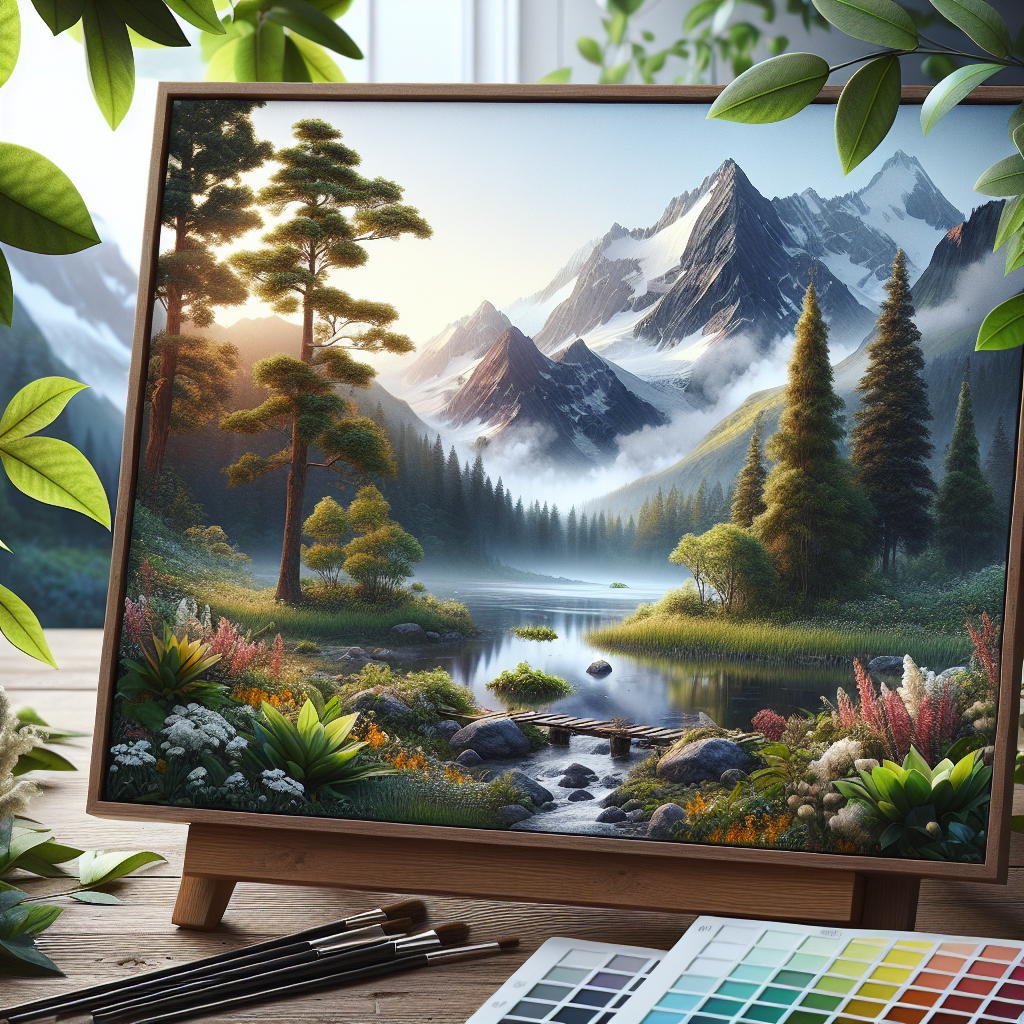How Much Art to Put on Walls? Find the Perfect Balance!
Share
Creating a harmonious and visually appealing space often hinges on finding the right balance of wall art. The question of how much art to put on walls can be daunting, especially when aiming for a blend of sophistication and personal expression. The key lies in understanding the dimensions of your space, the style you wish to convey, and the emotional impact you want to achieve.
When contemplating wall art, consider the size and scale of your room. A large, expansive wall can become a stunning focal point with a single, oversized piece or a carefully curated gallery. Conversely, smaller walls benefit from modest-sized art that complements without overwhelming the space. The goal is to maintain a sense of proportion and symmetry that enhances the overall aesthetic.
It's also crucial to reflect on the style and theme of your decor. Modern, minimalist designs might call for fewer, statement pieces, while eclectic or traditional spaces could embrace a more varied collection. Each piece of art should resonate with the room's purpose and the emotions you wish to evoke, whether it be tranquility, inspiration, or vibrancy.
By thoughtfully selecting and placing your art, you can transform any room into a gallery of personal expression. Explore handcrafted modern art by metal artist Christopher Henderson to find unique pieces that speak to your taste and elevate your surroundings.
Understanding Wall Space Dimensions

Before diving into the selection of art, it's essential to understand the dimensions of your wall space. The size and layout of your walls play a crucial role in determining how much art to put on walls effectively. Begin by measuring the width and height of each wall where you intend to display art. This will help you visualize the potential layout and ensure that your pieces are appropriately scaled for the space.
One common guideline is the 57-inch rule, which suggests that the center of any artwork should be approximately 57 inches above the floor. This standard, often used in galleries, aligns the artwork with the average human eye level, creating a natural and comfortable viewing experience. However, this rule can be adjusted based on ceiling height and personal preference.
It's also important to consider the negative space around your artwork. Too much empty space can make a piece feel isolated, while too little can create a cluttered and overwhelming look. Aim for a balanced arrangement where each artwork is given room to breathe, enhancing its visual impact without overcrowding the wall.
For larger walls, consider the use of multiple pieces arranged in a cohesive manner, such as a grid or a salon-style gallery wall. This approach can fill the space effectively while adding depth and interest. On smaller walls, a single, well-chosen piece can make a significant statement without overwhelming the area.
By carefully assessing your wall space dimensions, you can create an art arrangement that not only fits well but also complements and enhances the overall aesthetic of your room.
Choosing the Right Art Pieces

Selecting the right art pieces is a crucial step in achieving the perfect balance for your walls. When considering how much art to put on walls, it's not just about quantity but also about the harmony and cohesion of the chosen pieces. Begin by defining the purpose and mood you want to convey in each room. For example, a serene bedroom might benefit from calming, abstract pieces, while a lively living room could be enhanced with bold, vibrant artwork.
Consider the existing color palette and interior design style of your space. Your art should complement these elements rather than clash with them. If your room features neutral tones, you might opt for art with pops of color to create a focal point. Conversely, if your space is already vibrant, more subdued art can provide balance.
Mixing different types of art can add depth and interest to your walls. Combining paintings, prints, photographs, and even three-dimensional pieces like metal sculptures can create a dynamic visual experience. However, ensure there is a unifying theme or element, such as color scheme or subject matter, to maintain coherence.
Pay attention to the scale of the art pieces in relation to your wall space. Large walls can accommodate bigger or multiple pieces, while smaller walls are better suited for more modestly sized artwork. Additionally, consider the frame styles and matting, as these can significantly impact the overall presentation and integration of the art within the room.
Ultimately, the art you choose should resonate with you on a personal level. It should evoke emotions, spark conversations, and reflect your personality and taste. By thoughtfully selecting art pieces that align with your vision, you can create a harmonious and inspiring environment.
Arranging Art for Visual Impact

Once you've selected the right art pieces, the next step is to arrange them in a way that maximizes their visual impact. The way you position your art can dramatically alter the ambiance of a room and enhance the overall aesthetic appeal. Start by considering the focal points of your space. These are typically areas where the eye is naturally drawn, such as above a fireplace, a couch, or a bed.
One popular technique is to create a gallery wall, which involves grouping multiple pieces of varying sizes and types together. This arrangement can be eclectic and dynamic, making a bold statement. To achieve a cohesive look, maintain a consistent spacing between pieces and use frames that complement each other. You can lay out your arrangement on the floor first or use paper templates on the wall to visualize the final look before hanging the actual pieces.
For a more minimalist approach, consider the power of symmetry. Placing two or more identical or similar pieces side-by-side or in a grid pattern can create a sense of order and balance. This method works particularly well in more formal or traditional spaces.
The height at which you hang your art is also important. A common guideline is to position the center of the artwork at eye level, which is typically around 57 to 60 inches from the floor. However, this can vary depending on the height of your ceilings and furniture. For example, when hanging art above a sofa or headboard, the bottom edge of the frame should be about 6 to 12 inches above the furniture.
Don't be afraid to experiment with unconventional placements. Art doesn't always have to be centered on a wall; asymmetrical arrangements can add a modern and intriguing touch. Remember to consider the lighting as well, as it plays a crucial role in highlighting your art. Natural light can enhance colors and textures, while strategically placed artificial lighting can create dramatic effects.
By thoughtfully arranging your art, you can create a visually stimulating environment that not only showcases your collection but also elevates the overall design of your space.
Considering Room Function and Style

When deciding how much art to put on walls, it's essential to consider the function and style of each room. Different spaces in your home serve various purposes, and the art displayed should enhance the room's function while reflecting its style.
Start with the living room, often the most social area of the home. This space is perfect for bold, eye-catching pieces that can serve as conversation starters. Large-scale artworks or a curated gallery wall can add personality and vibrancy to the room. Consider the existing color palette and decor style—whether it's modern, traditional, or eclectic—to ensure your art complements the overall aesthetic.
In the dining room, art can set the tone for dining experiences. Opt for pieces that evoke a sense of elegance and sophistication. Landscapes, still lifes, or abstract art in calming colors can create a pleasant dining atmosphere. Ensure that the art is hung at eye level when seated to be fully appreciated during meals.
Bedrooms are personal sanctuaries, and the art here should promote relaxation and comfort. Soft, soothing colors and themes can enhance the serene environment. Consider placing a large piece above the headboard or creating a smaller gallery wall with sentimental artwork that brings joy and peace.
Home offices benefit from art that inspires and motivates. Choose pieces that stimulate creativity or reflect your professional interests. Abstract art, motivational quotes, or landscapes can provide a refreshing visual break during work hours. The art should be positioned where it can be easily seen from your desk.
Bathrooms are often overlooked spaces for art, but they can benefit from well-chosen pieces too. Small, moisture-resistant artworks can add character and charm. Consider pieces that reflect the bathroom's color scheme and style, such as nautical themes for a coastal-inspired bathroom.
By thoughtfully selecting and placing art according to the function and style of each room, you can create harmonious and visually pleasing spaces that enhance your home's overall design.
Tips for Avoiding Overcrowding

When determining how much art to put on walls, it's crucial to avoid overcrowding, which can make a space feel cluttered and overwhelming. Here are some tips to help you strike the perfect balance:
- Leave Breathing Room: Ensure there is enough space between each piece of art. This allows each piece to stand out and be appreciated without competing for attention. A good rule of thumb is to leave at least 2 to 3 inches between frames.
- Focus on Quality, Not Quantity: It's better to have a few impactful pieces than to cover every inch of wall space. Select artworks that truly resonate with you and enhance the room's ambiance.
- Consider the Scale: Large walls can handle bigger pieces or a collection of smaller ones arranged in a gallery style. For smaller walls, choose fewer, appropriately sized artworks to avoid overwhelming the space.
- Use a Visual Anchor: Anchor your arrangement with a central piece that draws the eye. This could be a large painting, a striking sculpture, or a unique wall clock. Build around this anchor with complementary pieces.
- Plan Your Layout: Before hammering nails into the wall, lay out your art on the floor to visualize the arrangement. This allows you to experiment with different configurations and find the most balanced layout.
- Embrace Negative Space: Don't be afraid of empty walls. Negative space can be a powerful design element, providing visual relief and highlighting the art you do choose to display.
Achieving the perfect balance of art on your walls can transform your home into a sophisticated and stylish haven. Remember, the goal is to create a harmonious environment where each piece of art can shine.
Explore handcrafted modern art by metal artist Christopher Henderson to find unique pieces that perfectly complement your space. Visit Modern Elements Metal Art today and discover the possibilities.






